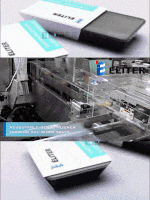PET Packaging Production Process
2022-12-13
Do you know what PET is?
Do you know the types of PET that exist?
What is your production process? What applications does it have?

The process for the production of packaging is described below:
The resin is presented in the form of small cylinders or chips, which dry are melted and injected under pressure in multi-cavity machines from which the preforms are produced (containers not yet inflated and that only present the mouth of the container in definitive form). Then, the preforms are subjected to a precise and gradual heating process, then they are placed inside a mold and stretched by means of a rod or piston until they reach their final size, then they are inflated with pressurized air until they take the shape of the mold and the typical package is formed.
Using a flowchart, the complete production process of a PET container is described, considering from the raw material to the finished product.
General characteristics
Among the most important characteristics that the PET presents, there are:
- Good behavior in the face of permanent efforts
- Crystallinity
- High wear resistance
- Very good sliding coefficient
- Good chemical resistance
- Good thermal properties
- Very good barrier to CO2, acceptable barrier to O2 and humidity.
- Fully recyclable
- Approved for use in products that must be in contact with food products.
- Intrinsic Viscosity: The VI (Intrinsic Viscosity) of the material is dependent on the length of its polymer chain. The longer the polymer chain, the stiffer the material and therefore the higher the VI.
- Light
- High degree of transparency and gloss, which preserves the taste and aroma of food.
The physical properties of PET and its ability to meet various technical specifications have been the reasons why the material has reached a relevant development in the production of textile fibers and in the production of a wide variety of packaging, especially in the production of bottles, trays, strapping and sheets.
Application
Among some of the applications that PET has, there are: carbonated beverage containers, mineral waters, oil, juices, teas, wines and alcoholic beverages, detergents and cleaning products, cosmetic products, sauces and other foods, chemical products and lubricants, products for agricultural treatments, films, food containers, audio/video tapes, photography, electrical, electronic applications, special packaging and X-ray.
Other uses:
- * Pipes, profiles, walls, injected parts
- * Fibers, textiles, frames, construction
How does the PET packaging recycling process work?
The PET packaging recycling process consists of three stages:
Stockpiling
During this stage, it is collected and transported to a center, where it is segregated, decontaminated, compacted or ground and stored. The result of this stage is dirty flake and bales of bottles.
Recycle
Recycling is an industrial process based on physical, chemical and thermal processes, in which dirty flakes or bales pass to other types of industries where the second stage is carried out, consisting of grinding, washing of the flakes, chemical control, separation, drying, pelletizing, post-condensation and storage.
Manufacturing
the third stage is where the already cleaned flake is sold to product manufacturers, which from these inputs produce bottles, pillows, face masks, coifs, strapping, plastic, paint rollers, thermal filler fiber for jackets and sleeping bags, polyester fiber for clothing and even food-grade packaging.




